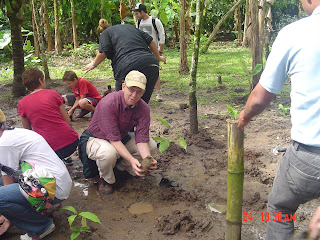 |
| Some Romantic Dominican Orchids |
A couple of weeks ago our school helped to sponsor a tour to a cacao (cocoa) plantation. I don’t know about you but the word “chocolate” brings many feelings of mystery and enchantment. Meeting at our school one Saturday afternoon in March three dozen teachers and families packed into the small school-owned bus to ride to the Rizek Cacao plantation located near San Francisco de Macoris, a town less than two hours away from our city of Santiago. This tour led us on a four-hour memorable journey through the chocolate world. Years ago when my son and I flew back to the East coast from Idaho to pick up a car for a friend, we stopped in Hershey, Pennsylvania to tour the chocolate factory there. The aromas and delicious processes that were exposed to us from the confines of the tour train in that sanitized factory was quite different from this rustic trail of organic cacao trees that meandered through the Hacienda La Esmeralda.
Don’t get me wrong. Both tours were quite fascinating but I have the distinct impression that this tour revealed what happens to create the chocolate that Hershey gets to begin their process. As this pamphlet advertised: “Donde nace el chocolate.” (Where chocolate begins.)
The tour guide spoke English well enough to be understood and guided us through the five main steps of creating chocolate.
1. Planting
 |
| A grafted plant |
 |
| They let anybody plant |
2. Cacao Pod
 |
| The pulp on the seeds tastes sweet |
 |
| Cacao pods grow on shade trees |
 |
| Harvesting the pods |
3. Fermentation
 |
| Whew! Smells just like silage! |
This is an organic industry so the leaves from the trees are left on the ground, and after the seeds are harvested the pods are also scattered back into the soil. The seeds are placed into huge bins where they are rotated while they ferment. I wished I could have snapped a picture of the children as we entered the fermentation center. They held their noses not knowing what to make of the unpleasant smell. To me it smelled just like the silage pit where I used to feed the dairy cows, so it reminded me of my childhood.
4. Drying
The fermented seeds are then placed into long well-ventilated sheds where they dry. When the seed is dried it has a thin shell around the dark colored nut not entirely unlike a peanut. If a person rubs off the shell with his thumb and forefinger it reveals the black “nut”. When tasted, it has a strong taste of what we all know and love, but it is soooooooo bitter!
 |
| Soooooo bitter! |
5. Processing
 |
| Traditional chocolate processing |
 |
| This song definitely had a "beat" |
Because of the large percentage of cocoa butter in the seeds this process turns the seeds into a shiny paste that looks like black, thick peanut butter. This paste can now either be separated into cocoa butter and cocoa powder, or in can be processed into dark chocolate bars by adding sugar and other ingredients and then refined and tempered.
 |
| All decked out |
To complete the tour we sat at some rustic tables in an outdoor shelter that had butterflies embedded in a thick polyethylene table top. They served a lavish, tasty lunch and entertained us with lively merengue music that made you want to get up and dance.
 |
| Dancing to Merengue |
My wife and I have little chance to get outside the city limits since we don’t have a car, so this excursion was more than “an enjoyable journey through the chocolate world”. We had the chance to spend a day with teachers from my school and see a part of the island that we don’t usually get to see … the rural areas. As we passed by fields of yucca (a root similar to a potato), batata (similar to a sweet potato), guineo (bananas), yautia (a weird but common cooking root) we marveled at the beauty and freshness of this land. When we came here four years ago we were only going to stay two years. Now, with plans to come back next year, we realize we are staying longer than we planned. For as long as we are here we want to walk worthy of God and be strong in the Word of God which effectually works in us that believe. This small journey into romance and adventure has encouraged us to do that.
That ye would walk worthy of God, who hath called you unto his kingdom and glory. For this cause also thank we God without ceasing because when ye received the word of God which ye heard of us, ye received it not as the word of men, but, as it is in truth, the word of God, which effectually worketh also in you that believe.
I Thess 2:12,13


No comments:
Post a Comment